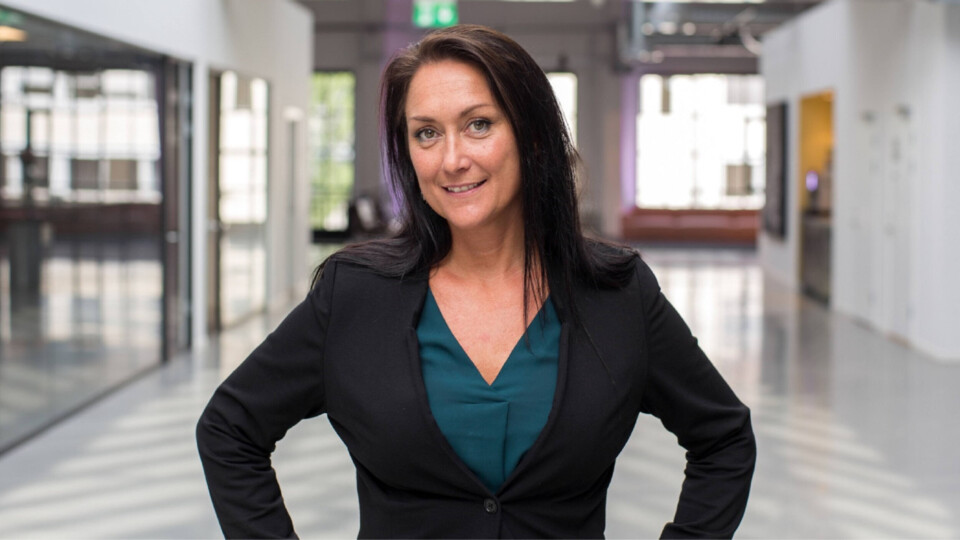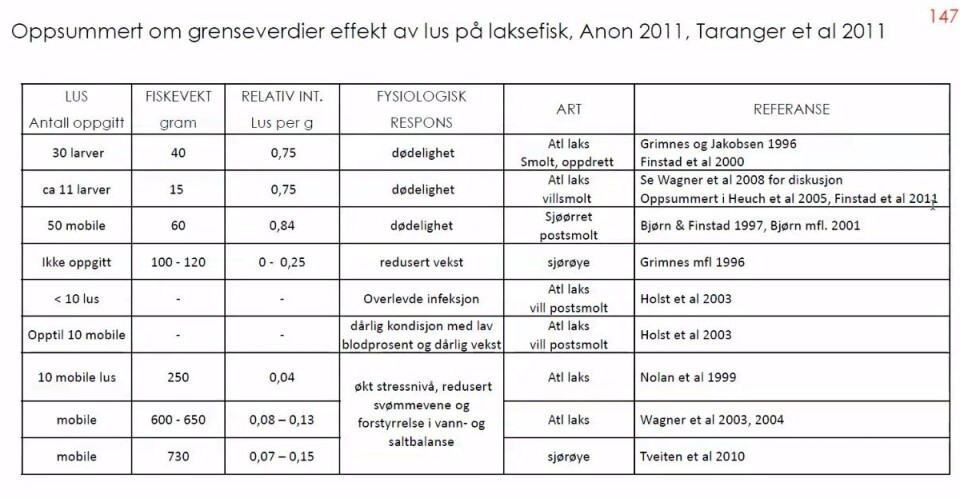
Lice lethality level to smolts challenged in court
The expert group that decides on fish production levels under Norway’s “traffic light” system is wrong when it concludes that more than 0.3 lice per gram of body weight always leads to death of wild smolts, former Nofima researcher Solveig van Nes believes.
Solveig was giving evidence as an expert witness in a case against the state by the 25 salmonid farmers in production area 4 (PO4), one of 13 production areas along Norway’s coast.
The farmers, including Mowi and Scottish Sea Farms co-owner Lerøy, are contesting the basis of the “red light” given to PO4, which means production must be reduced by 6% to protect wild salmon from sea lice from salmon pens.
Van Nes currently runs her own company, Marine Prospects AS, and was commissioned by the farmers to review the scientific literature basis for the lice limit values used by the expert group to conclude that there is a high probability of great influence on wild fish in PO4.
Partial misunderstanding
She has examined the scientific articles referred to when setting the limit and believes that it can be shown that the expert group partly misunderstand and partly do not take into account criticism of this.
The expert group write in their report that they use data from a report called Taranger 2012 for their lice limits. The expert group concludes that if fish have more than 0.3 lice / gram fish, then 100% will die. This level is also used by the Scientific Council for Salmon Management.
Van Nes thinks she can document this is far too strict. According to the reports she refers to, the fish can withstand a good deal more than this.

Differing conclusions
Van Nes has made a table that shows the main conclusions in the various studies that the expert group refers to. The table (in Norwegian) is on the right.
She pointed out that these studies differ greatly in what conclusions are drawn, where there are different sizes of fish that have been examined, and not everything has been done on salmon.
“I cannot characterise this as particularly solid, but on the contrary quite thin when it comes to Atlantic salmon,” she said.
Sea trout
One of the reports is, among other things, based on data from sea trout.
“I do not understand how they think it is transferable to, for example, look at char of 750 grams, which according to the table should only withstand 0.07-0.15 lice per gram, when other experiments with smaller salmon show 0.75.”
One publication that was central to her testimony was Wagner et al. from 2008. She believes this shows that the numerical basis is incorrect, and that the expert group has not taken note of it.
It criticises, among other things, several of the articles on which the expert group has based its conclusions on how many lice it takes to kill a smolt.
‘Confusion exists in the literature’
She drew several quotations from it: “Some confusion exists in the literature with regard to laboratory estimates of pathogenicity of salmon lice, beginning with the suggestion that >30 louse larvae can cause death in 40 g Atlantic salmon post smolts.”
“Reference is made here to a work by Grimnes and Jakobsen 1996, which is central to the expert group, which uses the term larvae for what is pre-adult,” she said.
In the Wagner et al. article, it is pointed out that another key work for the expert group is Finstad et al. 2000, which in turn uses Grimnes and Jakobsen 1996 as a starting point for its conclusions. Also, it is pointed out that a work by Heuch et al. from 2005 makes mistakes and misinterprets Grimnes and Jakobsen.
She further cited from Wagner et al. his critical article:
“Finstad et al., who reference the study by Grimnes and Jakobsen, suggest that 30 chalimus larvae, or a relative intensity of 0.75 chalimus larvae g ¯¹fish, might kill a post-smolt when the parasites become pre-adults. Either the authors assume the same effects across differing parasite stages, which is not consistent with the rest of the literature, or they disregard natural mortality between stages. However, there is a 30-50% natural decrease in Lepeophtheirus salmonis numbers over time due to mortality and dislodging in laboratory investigations between chalimus and pre-adult moults. In other words, suggesting a threshold of 30 or more pre-adult lice causing mortality in 40g post-smolt Atlantic salmon would be closer to 60 chalimus larvae infecting size-matched Atlantic salmon, as observed by Grimnes and Jakobsen.”
“They are thus quite clear that this is data that is often misinterpreted, and they are quite specific that Finstad et al., which is thus used as a basis in the traffic light system, is wrong,” she said.
“It is striking that the expert group has never made changes in relation to this, I want us to note it,” she added.
Natural reduction of lice
Van Nes elaborated on why it was important to focus on the fact that there is a natural reduction of lice on the fish from the time it becomes infected, until the lice become adults.
“It is therefore important to distinguish between talking about lice larvae or adult lice. I think this is treated very differently in the basis of the traffic light system. In fact, the 2020 report admits that the number of lice is probably overestimated, e.g: you do not take into account the stages of lice you have counted on the fish you have caught with trawls. I think this is striking,” she said.
She then pointed out that in the literature one finds data on everything from 40-50% to as much as 80% decreases from the number of chalimus to pre-adult.
“[Expert group deputy leader] Frank Nilsen himself said in his diploma that they had a rule of thumb that there is a mortality on the lice on the fish of 50%. I think it is surprising and professionally wrong that one does not assume lice mortality when using trawl data,” she said.
Population effect
She also criticised the way on which the effect of a certain lice level on an individual fish is extrapolated into the effect on the whole population.
“I believe that when one translates the limit values that they have set on individual fish, to population effect, then it is very wrong.”
Van Nes referred to a study where one had put out and treated half of the smolt with lice repellent and the other half not.
“This field trial concludes that in absolute value the difference in mortality is 1% from lice. On average, 93% of mortality is explained by other causes. But the expert group talks about 30% mortality from lice. If that were the case, there would be no salmon left,” she said.
“What is worrying in this study is the large decline that is seen in both groups (of smolts), which indicates that there is a huge decline in marine survival. In other words, it is strong forces in the ocean that affect survival. These forces are what one should focus on. Maybe one should make sure that there were more smolts that could swim out of the rivers.”
Are lice harmful?
Government lawyer Hilde Lund asked, as she has done to most of the witnesses, whether they think salmon lice are harmful to wild salmon.
“It is a very open question you ask,” replied Van Nes. “Do you mean at the individual level? The small stages are demonstrably not harmful, but when they develop and become pre-adults and adults, they can of course do great damage at the individual level.”
Lund pointed out that Van Nes had challenged the lice limit value and asked her if she had any suggestions what the limit should be.
“Now, it’s not really me who claims that they are wrong. I refer to a review article that has been peer reviewed. The level to be used must be up to the experts. I point out that there is no documentation to say that ‘all fish die’ if they get over 0.3 lice. All available literature says from 0.5 to 1. What I have done is point out the criticisable use of references,” Van Nes replied.
Are you a lice expert?
Lund challenged Van Nes on whether she would call herself a salmon lice expert herself.
“I have a very good understanding of methodology, I am absolutely capable of showing when one has made a wrong use of data when it is concluded. I refer to other literature where completely different values appear,” said the witness.
“So you think the expert group is wrong,” asked Lund.
“I do not say that the whole group is wrong, not everyone there works with limit values. But it is also human to make mistakes, and therefore it is important to have a discussion with people who have a different opinion. More than half of the references in the expert group report are made by those who are there. Thus, they sit and evaluate their own work, but it is also important to spar with others who see it in a different way, or can contribute new knowledge,” Van Nes said.
Publish in English
Van Nes also explained that it could be a challenge that all the reports on the traffic light system are published in Norwegian.
“Many of the experts around the world will thus have difficulty pointing out errors. There may be a point that they should either be published in English or made available in another way.”
“Is there a decision then,” asked Lund.
“I think there is documentation at a more correct level, but you will never get any conclusion, this is biology. But you can always work to get more knowledge,” said Van Nes.























































